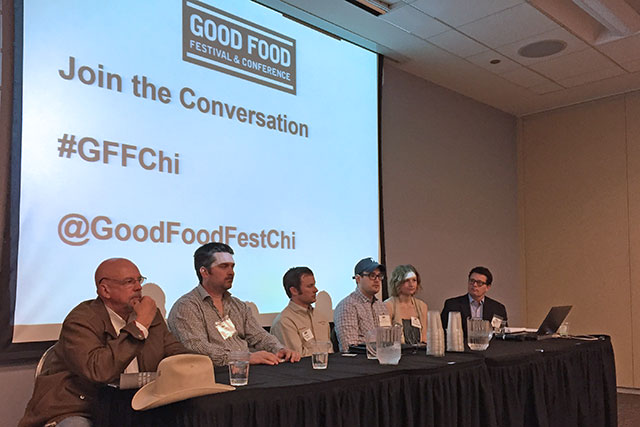A Discussion On Scaling Up Local Meat
By Melissa McEwen in Food on Apr 13, 2015 3:00PM

From left to right: Will Harris (White Oak Pastures), Greg Gunthorp (Gunthorp Farms), Louis John Slagel (Slagel Family Farm), Rob Levitt (The Butcher & Larder), Raya Carr (Mint Creek Farm), John-Mark Hack (Moderator, Local Food Association)
As consumer demand grows for locally-raised pastured meat, many farmers are having trouble keeping up. At last month's Good Food Festival they brought together a panel of meat experts from across the country to discuss the challenges of scaling up to meet greater demand.
The main challenge, which took up most of the discussion, was dealing with regulations. "It's a one size fits all regulatory environment. With [large] competitors compliance costs are fraction of ours, per product basis, because USDA doesn't consider scale of risk," said John-Mark Hack, the panel's moderator, who is a farmer in Kentucky and the director of The Local Food Association.
Several of the panelists have managed to build USDA-processing plants on their farms, a true challenge, but one that allows them to meet greater demand. Rather than taking their animals to another place to be slaughtered and processed into everything from whole animals for chefs to packaged bacon, they do it all on farm.
"A big advantage of running a processor is the flexibility to meet customer's needs. You can control all aspects of the product and not lose touch with it. You can cut it a certain way to meet chef's specifications which would be really tough using an [outside] processor. We can also meet late orders this way," said Louis John Slagel of Slagel Family Farm.
"We couldn't do what we do without a processing plant on farm, because there aren't poultry options and we couldn't get fresh red meat for restaurants," said Greg Gunthorp of Gunthorp Farms.
Slagel and Gunthorp are widely known for providing meat for some of Chicago's top restaurants. Slagel provides meat to restaurants like Publican and Gunthorp's largest customer is Rick Bayless.
Raya Carr of Mint Creek Farm, which also provides to many Chicago restaurants, said since they don't have their own processing facility they use an outside processor. This means they can't use their own sausage recipes or get their poultry organic certified since the processor isn't certified.
But while having on-farm processing facilities can be a huge advantage, building them wasn't easy and neither is running them. "It was a huge huge regulatory hurdle in my opinion, no major issues, but it's a constant regulatory challenge," says Gunthorp. "The amount of paperwork I have to do could take up at least one or two full time jobs…could I afford to pay a full-time person responsible for that? No… Regulations used to be more specific, now many are vague and things depend on what inspector you get - you have to justify everything you do every single day. "
Will Harris, visiting from his farm White Oak Pastures in Georgia, known for their pastured chicken and beef, added "We do a lot of different things and I like everything we do, but the part I like least is meat processing. I was reading a business magazine and it listed twelve factors that make a business risky such as being highly regulated and every one of them applies to our business. But we want to farm a certain way and this helps us develop a channel to a sophisticated consumer."
Gunthorp is one of the few small farmers on a working group organized by Meridian called the Meat and Poultry Dialogue Group aimed at revamping meat and poultry regulations. He's not hopeful for big changes though and in the meantime he says "we need to educate consumers on why local sustainable products have a higher cost."
That's where chefs and other meat sellers like butcher Rob Levitt of The Butcher and Larder come in:
"We are partnering up with Local Foods for a bigger space and to work more with whole animals. We're trying to appeal to a much more diverse clientele. Sure, we have customers who have all the money in the world and can buy whatever they want, but we also appeal to a younger generation that's very aware and concerned about what they eat but they don't have a lot of money to spend. With whole animals we present cuts of meat that people can afford and we can tell them how to cook them."
Ultimately though consumer education is critical, Gunthorp emphasizes that "We need more farmers. And more commitment to getting existing processing plants up to scale." Unfortunately many efforts to expand small plants have been stymied, like the rapidly growing Black Earth, which was shut down by the dreaded NIMBYs.
And it can be a challenge for small farmers to grow. "We have only fifty cows, a few hundred sheep— we need to grow because we're probably too small for long term financial stability. But it's a chicken and egg thing, we need money to grow but how do we get money without growth?" says Carr. "We're hoping to build business enough this year to be able to expand."
As for Gunthorp, he says they are at the point where they are not taking on new customers, as "existing customers are all we can keep up with." It's a good sign that demand is there, but success will depend on weathering the challenges of high regulation and consumer education.